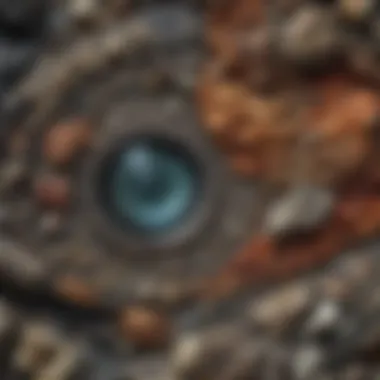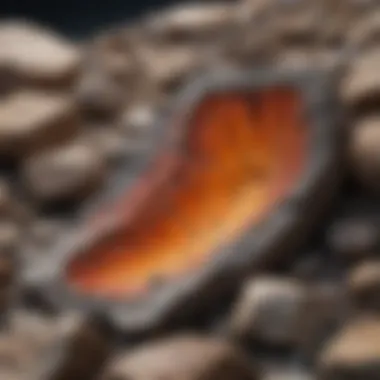Unlocking the Wonders of Petrographic Microscope Slides: A Comprehensive Exploration


Rock and Fossil Identification
Delving into the realm of petrographic microscope slides unlocks a treasure trove of knowledge on identifying various types of rocks and fossils with unparalleled precision and detail. These slides serve as windows into the intricate world of geology, allowing enthusiasts and experts alike to scrutinize the composition and characteristics of different geological specimens with meticulous clarity.
Types of rocks and fossils
Petrographic microscope slides enable the examination of a diverse range of rocks and fossils, ranging from sedimentary to igneous and metamorphic rocks, each exhibiting unique features that provide vital clues about their formation and geological history. Fossils, preserved remnants of ancient life forms, offer intriguing insights into prehistoric ecosystems and evolutionary processes.
Characteristics to look for
When scrutinizing rocks and fossils through petrographic microscopy, attention to detail is key. Features such as mineral composition, crystal structure, grain size, and texture play a pivotal role in distinguishing different rock types and identifying key geological formations. Fossils, on the other hand, exhibit distinct preservation patterns, morphological characteristics, and sedimentary context that shed light on past environments.
Tools for identification
Achieving accurate rock and fossil identification requires an arsenal of specialized tools, including petrographic microscopes equipped with polarizing filters for enhanced clarity, thin sections of rocks and minerals for detailed analysis, and various chemical and optical techniques to unravel the intricate makeup of geological specimens. By harnessing these advanced instruments, geologists and fossil enthusiasts alike can unlock the hidden secrets embedded in petrographic microscope slides.
Introduction to Petrographic Microscope Slides
In the vast realm of geological exploration, petrographic microscope slides stand as intricate gateways to the hidden world of mineralogical wonders. These slides, meticulously crafted with layers of sedimentary tales and crystalline mysteries, play a pivotal role in unraveling the enigmatic compositions of rocks and minerals. As we embark on this journey of discovery within the realm of petrography, we are bound to encounter a fusion of art and science, where each slide encapsulates eons of geological evolution in its compact structure.
What Are Petrographic Microscope Slides?


Petrographic microscope slides are miniature universes encapsulated within a thin layer of glass, holding within them a treasure trove of geological information. These slides are painstakingly prepared by skilled technicians, who slice rocks into thin sections, polishing them to reveal intricate details invisible to the naked eye. Each slide serves as a window into the past, allowing geologists and enthusiasts alike to peer into the complex histories preserved within rocks and minerals.
Significance in Geological Studies
The significance of petrographic microscope slides in geological studies cannot be understated. These slides act as time capsules, preserving moments in Earth's history with unparalleled clarity and precision. By analyzing the mineralogical structures and textural features present in these slides, geologists can reconstruct the ancient environments in which rocks formed, unraveling the stories locked within the Earth's crust. Through petrographic analysis, scientists can trace the evolution of geological formations, unlocking clues to the past that shape our understanding of the present.
Key Components of Petrographic Microscope Slides
At the core of every petrographic microscope slide lies a delicate balance of key components that work in harmony to unveil the hidden secrets of rocks and minerals. The thin section, mounted and polished to perfection, serves as the foundation for microscopic exploration. Embedded within this section are minerals, each with its unique optical properties that aid in identification and interpretation. The cover slip, a protective shield of glass, ensures the longevity of the slide, safeguarding the delicate features within. Together, these components form a unified whole, offering a glimpse into the intricate world of petrography.
Preparing Petrographic Microscope Slides
The section on preparing petrographic microscope slides plays a pivotal role in this comprehensive guide as it forms the foundation for subsequent analysis and interpretation. Sample selection and preparation are critical aspects of this process, requiring careful attention to detail and precision. By meticulously choosing suitable samples that best represent the geological features under study, researchers can ensure the accuracy and relevance of their observations. This initial step sets the stage for the entire petrographic analysis, emphasizing the importance of thoroughness and methodical approach.
The thin sectioning process stands as a crucial technique in petrography, enabling researchers to obtain wafer-thin slices of geological samples for examination under the microscope. This intricate procedure demands skill and expertise to ensure the creation of high-quality thin sections that accurately capture the mineralogical composition and structural details of the specimens. Through precise cutting and grinding methods, geologists can unveil hidden insights within the samples, shedding light on their geological history and properties.
Mounting and polishing techniques serve as the final steps in preparing petrographic microscope slides, refining the thin sections for optimal viewing and analysis. By carefully mounting the thin slices onto glass slides with suitable mounting mediums, researchers can secure the samples in place and enhance clarity for microscopic examination. The polishing stage further enhances the transparency and smoothness of the slides, facilitating clear visualization of mineral textures and structures. Attention to detail during mounting and polishing is essential to ensure the integrity and quality of the petrographic slides, enabling precise observations and accurate interpretations of geological features.
Overall, the meticulous process of preparing petrographic microscope slides underscores the significance of attention to detail, precision, and expertise in the field of petrography. Each step, from sample selection to mounting and polishing, contributes to the overall quality and validity of the analysis, providing researchers with valuable insights into the intricate world of geological specimens.
Analyzing Petrographic Microscope Slides


Analyzing Petrographic Microscope Slides plays a vital role in understanding the intricate details of geological specimens. By meticulously examining slides under the microscope, researchers can uncover a wealth of information about the mineralogical composition and textural features of rocks and minerals. This detailed analysis allows geologists to piece together the geological history of a particular sample, unraveling the processes that have shaped its current form. Moreover, the insights gained from analyzing petrographic slides are essential for identifying key geological formations, understanding rock formations, and interpreting the environmental conditions under which the specimens were formed.
Observing Under the Microscope
Observing specimens under the microscope is a foundational step in the analysis of petrographic slides. This process involves carefully placing a thin section of the sample on the microscope stage and adjusting the magnification to observe the specimen's features in detail. By systematically scanning the slide, researchers can identify different minerals present in the sample, observe their crystal structures, and discern any textural variations. Through precise observation under varying lighting conditions and magnifications, geologists can document key characteristics of the specimen, paving the way for in-depth analysis and interpretation.
Interpreting Mineralogical Structures
Interpreting mineralogical structures is a critical aspect of analyzing petrographic microscope slides. Geologists examine the arrangement of minerals within a rock sample to deduce important information about its formation history and tectonic events that have influenced its development. By analyzing crystal shapes, sizes, orientations, and relationships between minerals, researchers can infer the conditions under which the minerals crystallized and the subsequent processes that altered the sample. This careful examination of mineralogical structures provides essential clues about the geological evolution of the specimen, shedding light on the complex interplay of geological forces that have shaped the Earth's crust.
Identifying Textural Features
Identifying textural features in petrographic microscope slides involves recognizing the spatial relationships between mineral grains, porosity, and other structural elements within a sample. Geologists pay close attention to the size, shape, and distribution of mineral grains, as well as any fractures, veins, or other features that may provide insights into the sample's history. By discerning textural features such as grain boundaries, mineral zoning, and deformation structures, researchers can infer processes like metamorphism, magmatic evolution, or sedimentary depositional environments. These observations help geologists reconstruct the geological processes that have influenced the formation and alteration of rocks, contributing to a more comprehensive understanding of Earth's dynamic geology.
Applications of Petrographic Microscope Slides
Petrographic microscope slides find extensive applications across various fields, proving to be indispensable tools for in-depth analysis and investigation. In this article, we delve into the pivotal role of petrographic microscope slides and their profound impact in geological studies, education, and industrial applications. By examining the key elements and benefits associated with the applications of petrographic microscope slides, we uncover a world of valuable insights and knowledge that ultimately shapes our understanding of the earth's composition and history.
Geological Research and Exploration
In the realm of geological research and exploration, petrographic microscope slides serve as paramount resources for geologists and researchers. These slides provide a microscopic view into the intricate structures and compositions of rocks, minerals, and fossils. By studying these slides, geologists can unravel the geological history of a region, identify mineralogical structures, and gain insights into the processes that have shaped the earth's features over millions of years. The information derived from petrographic microscope slides plays a crucial role in mapping out geological formations, understanding tectonic activities, and predicting potential mineral deposits, making them indispensable tools in the field of geology.


Educational Purposes in Geology
Educationally, petrographic microscope slides offer an invaluable resource for students and educators in the field of geology. These slides provide a hands-on approach to learning about rock and mineral identification, allowing students to observe and analyze geological specimens in great detail. By engaging with petrographic microscope slides, students can develop essential skills in mineral identification, rock classification, and geological interpretation. Additionally, these slides help bridge the gap between theoretical knowledge and practical application, enabling students to gain a deeper appreciation for the complexities of the earth's geological processes.
Industrial Applications in Material Analysis
Beyond geological research and education, petrographic microscope slides play a vital role in industrial applications, particularly in material analysis. Industries rely on these slides for conducting detailed examinations of construction materials, minerals, and ceramics. By using petrographic microscope slides, materials scientists can assess the quality, durability, and structural integrity of various materials, ensuring compliance with industry standards and specifications. Moreover, the information obtained from petrographic analysis aids in process optimization, quality control, and product development, making these slides essential tools in ensuring the efficiency and reliability of industrial processes.
Maintaining Petrographic Microscope Slides
Keeping petrographic microscope slides in pristine condition is paramount to ensure the accuracy and quality of geological observations. As these slides are essential tools in geological research and education, their maintenance plays a crucial role in preserving their integrity and longevity. Proper maintenance not only safeguards the investment made in creating these slides but also enhances the clarity of observations and the overall user experience.
One of the key aspects of maintaining petrographic microscope slides is adhering to effective cleaning and storage practices. Cleaning plays a vital role in removing any impurities or residues that may obstruct clear observation under the microscope. Utilizing soft, lint-free cloths and specialized cleaning solutions is recommended to gently wipe the slides without causing scratches or damage. Careful storage is equally important to prevent dust accumulation, moisture exposure, or accidental breakage. Storing slides in individual protective cases or slide racks in a controlled environment helps to shield them from external elements and potential damage.
Cleaning and Storage Tips
Cleaning petrographic microscope slides should be done meticulously to ensure optimal visibility and accuracy during observations. Start by gently blowing away any loose particles or dust from the slide's surface. Avoid using harsh chemicals or abrasives that may etch the slide or alter its composition. When cleaning, use a mild detergent solution or specialized cleaning fluid designed for microscope slides. Gently dab the solution on a soft cloth and carefully wipe the slide in a circular motion to remove any dirt or residue. Ensure thorough drying before storing the slides to prevent moisture-related issues.
To maintain proper hygiene, clean the microscope stage, objectives, and eyepieces regularly using recommended cleaning solutions and lens tissues. Store cleaned and dried slides vertically in slide trays or cabinets to prevent scratching or sticking. Avoid stacking slides directly on top of each other to minimize the risk of breakage. Additionally, store slides in a dry, dust-free environment away from direct sunlight or moisture sources. Proper storage can extend the lifespan of petrographic microscope slides and maintain their quality for future use.
Preventing Damage and Contamination
Preventing damage and contamination is essential for ensuring the longevity and reliability of petrographic microscope slides. Handle slides with care, avoiding rough handling or dropping, which can lead to fractures or scratches. Always hold slides by the edges to prevent fingerprint smudges or oil transfer. Utilize protective gloves when handling slides to minimize contamination from skin oils or debris. Inspect slides regularly for any signs of damage or wear, such as chipped edges or cracks, and address them promptly to prevent further deterioration.
When transporting slides, use secure containers or carrying cases to prevent jostling or impact-related damage. Labeling slides with relevant information using waterproof markers helps in organizing and tracking them efficiently. Store slides in a well-ventilated area with stable temperature and humidity levels to prevent warping or degradation. By implementing careful handling practices and storage protocols, petrographic microscope slides can remain in optimal condition, ensuring accurate and reliable observations for geological studies and research.
Future Trends in Petrographic Microscopy
Petrographic microscopy is a field undergoing rapid evolution, with future trends poised to revolutionize the way we analyze geological samples. Understanding these trends is crucial for professionals seeking to stay at the forefront of petrographic analysis. Advancements in imaging technology play a pivotal role in enhancing the resolution and clarity of petrographic microscope slides. By integrating cutting-edge imaging techniques such as polarized light microscopy and digital cameras, analysts can capture intricate details with unprecedented accuracy. This enhances the interpretive capacity of researchers, allowing for more in-depth analysis and clearer insights into mineralogical structures. ** The fusion of petrographic microscopy with digital analysis tools marks a significant shift in how geologists approach sample examination. Digital platforms facilitate the storage, organization, and cross-referencing of petrographic data, streamlining the analytical process and enhancing collaboration among researchers. Integrating digital tools also enables the application of advanced algorithms for feature recognition and quantification, leading to more precise and efficient data interpretation. Emerging applications of petrographic microscopy extend beyond traditional geological studies, venturing into multidisciplinary fields such as archaeology, forensics, and environmental science. By combining petrographic analysis with other scientific disciplines, researchers can gain holistic insights into complex systems and phenomena. This interdisciplinary approach fosters innovation and widens the scope of petrography, opening new avenues for exploration and discovery. The future of petrographic microscopy holds immense potential for revolutionizing our understanding of geological materials and processes, paving the way for groundbreaking discoveries and advancements.







